| ‘ J-PARC News - March 2016 (Issue #131) |
| Discovery of Hydride Ion "H-" Conductor (March 18, Press Release) - Potential for Developing Innovative Energy Devices Using Hydrogen Energy - |
|---|
| A research team comprised of Research Associate Professor Genki Kobayashi of the Institute for Molecular Science, Associate Professor Masao Yonemura of the High Energy Accelerator Research Organization (KEK/J-PARC) and others has developed a solid electrolyte-a new material allowing ion conduction of hydride (H-), the negative ion of hydrogen with promise for batteries with high electrical potential. These research results are not an extension of existing storage batteries or the development of fuel cells. They provide new possibilities for using the energy of hydrogen, and are expected to open a path to the development of energy devices with a completely new principle of operation. The crystal structure of this solid electrolyte was determined via neutron experiments at the Materials and Life Science Experimental Facility (MLF) and other sites, and function was confirmed with synchrotron radiation X-rays from SPring-8 (Large Synchrotron Radiation Facility). This research was supported by Strategic Basic Research Programs of Japan Science and Technology Agency (JST) and the Grants-in-Aid for Scientific Research (KAKENHI) of the Japan Society for the Promotion of Science. These research results were featured in the U.S. science journal Science on March 18, 2016. |
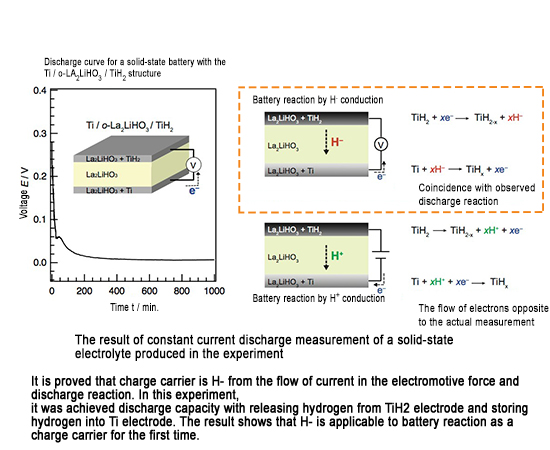
 * Click here to enlarge. * Click here to enlarge. |
| |
| £to Page Top |
| |
|
| Discovery of Superionic Conductor and Development of All-Solid Ceramic Battery (March 22, Press Release) - A Leading Candidate for High-Output, High-Capacity Next-Generation Electricity Storage Devices - |
|---|
| A research group led by Professor Ryoji Kanno of the Tokyo Institute of Technology and Associate Professor Masao Yonemura of KEK/J-PARC has discovered a ceramic superionic conductor exhibiting the world's highest lithium ion conductivity. The group has successfully developed an all-solid ceramic battery with output characteristics at least three times higher than conventional lithium ion secondary batteries by using the new conductor as the electrolyte of a storage battery. The crystal structure of the discovered superionic conductor was elucidated using the "IBARAKI Materials Design Diffractometer" (iMATERIA : BL20), a neutron powder diffractometer of the MLF, and the superionic conduction paths were clarified. In addition, the electrode reaction mechanism was compared with a lithium ion secondary battery using electrolyte solution, and it was determined that a high-output characteristic is an intrinsic advantage of an all-solid device. |
| On March 21, 2016, these research results were featured in the online version of the British science journal Nature Energy. |
| |

 * Click here to enlarge. * Click here to enlarge. |
| |
| £to Page Top |
| |
|
| International Advisory Committees (IAC 2016) (February 29 - March 1, J-PARC Research Building) |
|---|
| From the middle to the end of February, experts from inside and outside Japan were invited and various advisory committees were held to carry out a review, from an international perspective, of J-PARC facilities, operations, and related issues. There were meetings of committees on the Muon Science Establishment (MUSE) and accelerator facilities, and the Neutron Advisory Committee (NAC). At the NAC, there was a report on the results of a meeting by an international review committee on the 22nd for evaluations of the validity of the neutron target vessel design. In addition, an IAC for carrying out a general review of J-PARC by the higher ranking members of these committees was held from the 29th, and there were reports by J-PARC staff on the current status and future plans for facilities, and reports of meeting results from each committee. These reports were also discussed. The IAC indicated its recommendation that the previous track record be linked more closely to the results of science going forward. |
| |

 * Click here to enlarge. * Click here to enlarge. |
| |
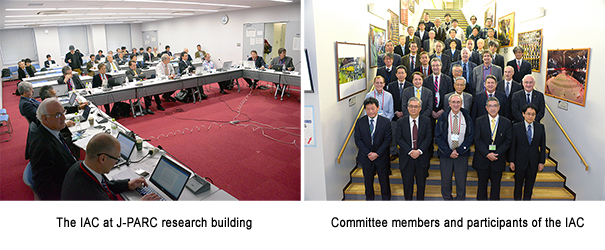
 * Click here to enlarge. * Click here to enlarge. |
| |
| £to Page Top |
| |
|
| Neutron Advisory Committee (NAC) (February 23-24, J-PARC Research Building) |
|---|
| Over the two days of February 23 and 24, the FY2015 Neutron Advisory Committee (NAC) meeting was held at the J-PARC Research Building. The NAC is an expert committee which carries out review, from an international perspective, of the 1 MW pulsed neutron source of the Materials and Life Science Experimental Facility (MLF), technical issues of neutron instruments, and matters relating to facility management and operations. The meeting was held by inviting as committee members 10 experts on neutron sources and neutron scattering from both inside and outside Japan, and the committee was chaired by Robert McGreevy, ISIS. At the NAC, there was a report by Chairman Bernard W. Reimer on the meetings results of the International Review Committee on the new design for the neutron target vessel held on the 22nd, the day before the NAC. This was prompted by the problems which occurred with the neutron target vessel (mercury target vessel) in 2015. In addition, there were general overviews of J-PARC and the MLF, reports on the current status and facility utilization. Situation for the neutron source, instruments, and neutron devices, and lively discussions on topics including the current state of industrial utilization of the MLF, measures to promote the production of results, and methods for handling user issues with unplanned beam stoppages. The results of the meeting of the NAC were reported at the J-PARC International Advisory Committee meeting held from February 29. |
| |

 * Click here to enlarge. * Click here to enlarge. |
| |
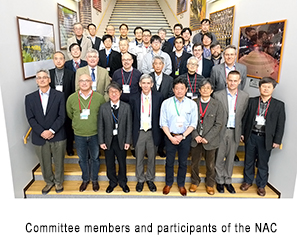
 * Click here to enlarge. * Click here to enlarge. |
| |
| £to Page Top |
| |
|
| Accelerator Technical Advisory Committee (A-TAC) (February 25-27, J-PARC Research Building) |
|---|
| Over the three days from February 25 to 27, the FY2015 meeting of the Accelerator Technical Advisory Committee (A-TAC) was held at the J-PARC Research Building. A-TAC is an expert committee for carrying out review, from an international standpoint, of technical issues with J-PARC accelerators, management/operation of facilities and other relevant topics, and the meeting was held by inviting 10 committee members who are experts on accelerators both inside and outside Japan. The committee was chaired by Thomas Roser of BNL. To begin, there were reports from the J-PARC side on the current status of the facilities as a whole, and on the accelerators. This was followed by reports from accelerator experts on topics such as the beam study and commissioning results for accelerators as a whole, plans for future upgrades of each accelerator, and the development status for the new beam injection system, fast extraction system, and electromagnet power sources for the 50 GeV synchrotron (Main Ring). The reports also included the response to advice received from the previous meeting, and there were lively discussions. The results of deliberation at A-TAC were reported at the J-PARC International Advisory Committee meeting held on February 29. |
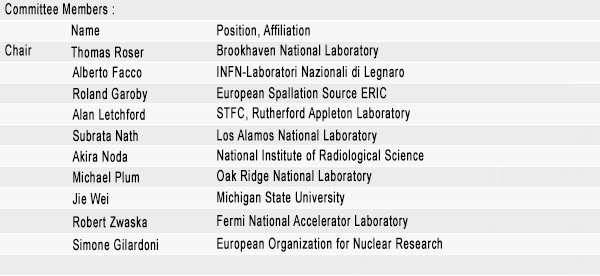
 * Click here to enlarge. * Click here to enlarge. |
| The results of the deliberations of this committee will be reported by the Chairperson B. Reimer at the Neutron Advisory Committee (NAC2016) to be held on the 23rd and 24th. |
| |
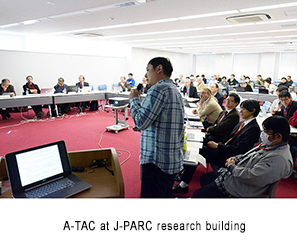
 * Click here to enlarge. * Click here to enlarge. |
| |
| £to Page Top |
| |
|
| 1st ANSTO-J-PARC International Research Collaboration Workshop (March 2-3, J-PARC Research Building) |
|---|
| Over the two days March 2 and 3, the 1st ANSTO-J-PARC International Research Collaboration Workshop (WS) was held at the J-PARC Research Building. In July 2015, the High Energy Accelerator Research Organization (KEK), Japan Atomic Energy Agency (JAEA), and the Australian Nuclear Science and Technology Organization (ANSTO) concluded a memorandum of understanding (MOU) on collaboration in the field of neutron science, and recently the approach to substantial research collaboration based on that MOU was discussed under the supervision of Mr. Anthony Murfett, Minister Counselor at the Australian Embassy in Washington, D.C. Twelve researchers attended from ANSTO, including CEO Adi Paterson. |
| At the opening, there were greetings by the representatives of each organization-Naohito Saito, Director of the J-PARC Center, CEO Adi Paterson, Kazuyoshi Yamada, Director the Institute of Materials Science, KEK, and Hideaki Yokomizo, Director of Tokai Center, Comprehensive Research Organization for Science and Society (CROSS). Then Rob Robinson, Head of the Bragg Institute, explained the background leading up to the MOU, and Toshiji Kanaya, Head of the Materials and Life Science Division, explained the gist of the agreement. At this WS, science, equipment development, utilization by industry, neutron polarization technology, deuteration technology, sample environment, and safety culture were selected as fields for research cooperation, and a program was developed through extensive discussions from the preparation stage by the Japanese and Australian coordinators in each field. The first day began with researchers from the two organizations and participants from Hiroshima University introducing research topics on soft matter, including solid-state physics and food science. There were also talks on current analysis at ANSTO and J-PARC, and directions for research cooperation, by coordinators in areas such as industrial utilization, neutron polarization technology, and the sample environment. |
| On the second day, there were talks by coordinators, introducing efforts relating to safety and deuteration technology for measurement samples. Parallel sessions were held in each field of cooperation, with talks by participants from Ibaraki University, CROSS, Kyoto University, and the JAEA Quantum Beam Science Center, and there was a lively exchange of views on the research collaboration process. At the end of the WS, there were session reports by each coordinator, a detailed review of each field of cooperation by Yukinobu Kitakawa, Subleader of the Neutron Science Section and Jamie Schulz, Operations Manager of the Bragg Institute, and a summary of the entire workshop by Dr. Kanaya and Dr. Robinson. After the workshop, there was a tour of user support facilities such as the laboratory currently under development on the first floor of the J-PARC Research Building, and the laboratory being developed by CROSS at the Ibaraki Quantum Beam Research Center. |
| On the 4th, a poster session was held in the atrium of the J-PARC Research Building jointly with the Japan-Australia International Workshop on Neutron Science held on the same day (organized by the Institute for Solid State Physics, University of Tokyo, and co-hosted by the J-PARC Center). |
| |
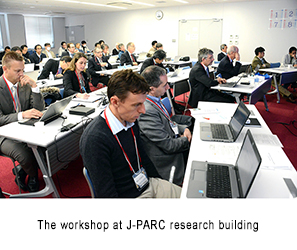
 * Click here to enlarge. * Click here to enlarge. |
| |
| £to Page Top |
| |
|
| International Workshop on Physics at the Expanded Hadron Experimental Facility (March 5-6, KEK Tokai Building No. 1) |
|---|
| As a representative of the scientist community in Japan, the Science Council of Japan is formulating a master plan for large-scale research in the sciences, and at present, they are publicly appealing for revisions and ideas for this master plan. Recently the Hadron Hall Users' Association, a community of users of the Hadron Experimental Facility, held a workshop focusing on expansion of the Hadron Hall as part of a plan for improving J-PARC. The participants included many researchers from inside and outside Japan who use the experimental facility, and throughout the workshop there were lively discussions on topics such as the outlook for research using a new beamline with higher brightness and precision, and the expansion of the hall that would be needed to implement that. |
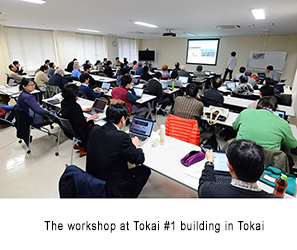
 * Click here to enlarge. * Click here to enlarge. |
| |
| £to Page Top |
| |
|
| FY 2015 Quantum Beam Science Festa (7th MLF Symposium) (March 15-16, Epochal Tsukuba) |
|---|
| The joint science festa of the KEK Institute of Materials Structure Science (IMSS) and the MLF was renamed this year as the "Quantum Beam Science Festa," and it was held at the Tsukuba International Congress Center on the March 15 and 16, with about 570 participants including those attending the MLF Symposium and PF Symposium on the second day. The MLF Symposium, held in parallel with the PF (KEK Photon Factory) Symposium on the second day, began with an MLF facility report by Toshiji Kanaya, Leader of the Materials and Life Science Division, on topics such as future plans, user programs, the development situation of instruments and other equipment, problems with the target vessel, and how those problems are being handled. After that, there was a memorial session for the late Dr. Noboru Watanabe and the late Dr. Kusuo Nishiyama who were deeply involved in the completion of the MLF pulsed neutron source and the pulsed muon science experimental facility, and eulogies were given by Dr. Hiroshi Takada, Leader of the Neutron Source Section, and Dr. Yasuhiro Miyake of the Muon Science Section, Head of Muon Science Division of IMSS, KEK. In a symposium special session, Professor Masato Okada of the University of Tokyo gave a talk entitled "Latent Structure Extraction from a Quantum Beam using Sparse Modeling," and there was a lively discussion of new directions for research based on a fusion of quantum beam science and computational science. To present requests from users, there was a report on results of a previous questionnaire survey from the MLF Users Group, and information was provided by staff from JAEA, KEK and CROSS in charge of experimental instruments regarding equipment and use experiments. This was followed by a lively question-and-answer session and exchange of views. Among the seven talks in the following two sessions, there was a lecture from the facility side entitled "Present Status of High-Intensity Beam Commissioning at MLF" as part of the move toward MLF 1 MW operation in the near future, and as a profile of a utilization experiment, a talk entitled "Analysis of Water Coating and Adhesive using Neutron Reflectivity" by Masanobu Naito, Principal Researcher, National Institute for Materials Science. |
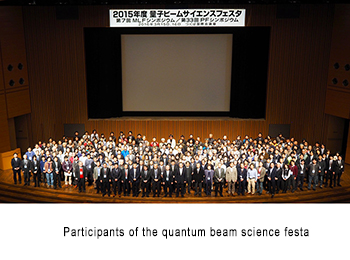
 * Click here to enlarge. * Click here to enlarge. |
| |
| £to Page Top |
| |
|
| MOU Signing Ceremony on Establishing a J-PARC Branch Office (March 18, J-PARC) |
|---|
| Osaka University and the High Energy Accelerator Research Organization (KEK) currently have an agreement to promote collaboration and cooperation between the two organizations. Osaka University has participated in many research projects using the Hadron Experiment Facility and other systems, and based on the cooperative agreement between the two sides, it was recently decided to establish the Osaka University J-PARC Center Branch Office at KEK Tokai Building No. 1, as a base for building a close cooperative relationship between the two at J-PARC. The signing ceremony for the Memorandum of Understanding (MOU) was held on the 18th at the J-PARC Research Building, and was attended by Naohito Saito, Director of the J-PARC Center and others. |
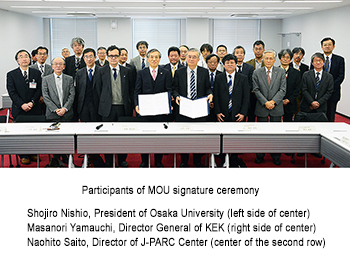
 * Click here to enlarge. * Click here to enlarge. |
| |
| £to Page Top |
| |
|
| Science Cafe : "Does Ibaraki Prefecture Really Rank Lowest in of Attractiveness!? - The Appeal of Ibaraki, using Neutrons to Examine Everything from the Riddle of Life to Food Culture"iMarch 19, Tokai-Mura Industry and Information Plaza) |
|---|
| At a Science Cafe organized by the JAEA, Hiroshi Nakagawa, Assistant Principal Researcher of the Quantum Beam Science Center, spoke on the theme mentioned in the title with J-PARC public relations advisor Shinichi Sakamoto acting as facilitator. Dr. Nakagawa is a researcher conducting experiments with neutrons at the MLF, and he first put the audience at ease by talking about his home prefecture and the ranking of prefectures in terms of attractiveness. Then he turned to the main topic. He discussed the neutrons used in life science research, the distinguishing features of neutron experiments, and how such research can aid drug development because it allows experimental investigation of the shapes and movements of protein and the information in DNA (genes). Proteins are chains of amino acids (in their unfolded state), but these chains first exhibit their functions when they fold and assume a three-dimensional structure. These differences in state were demonstrated in a "protein folding experiment" where heat was applied to a protein solution, resulting in a color change. In addition, in his talk about using neutrons to research the storage characteristics of foods, he used as an example "dried sweet potatoes," a noted product of Ibaraki Prefecture. There were many questions from the 20 participants regarding this topic from daily life. |
| |

 * Click here to enlarge. * Click here to enlarge. |
| |
| £to Page Top |
| |
|
©2016 J-PARC Center. All rights reserved.
|
|